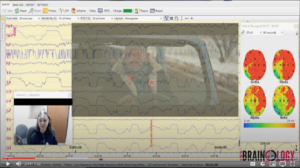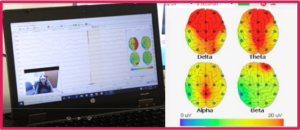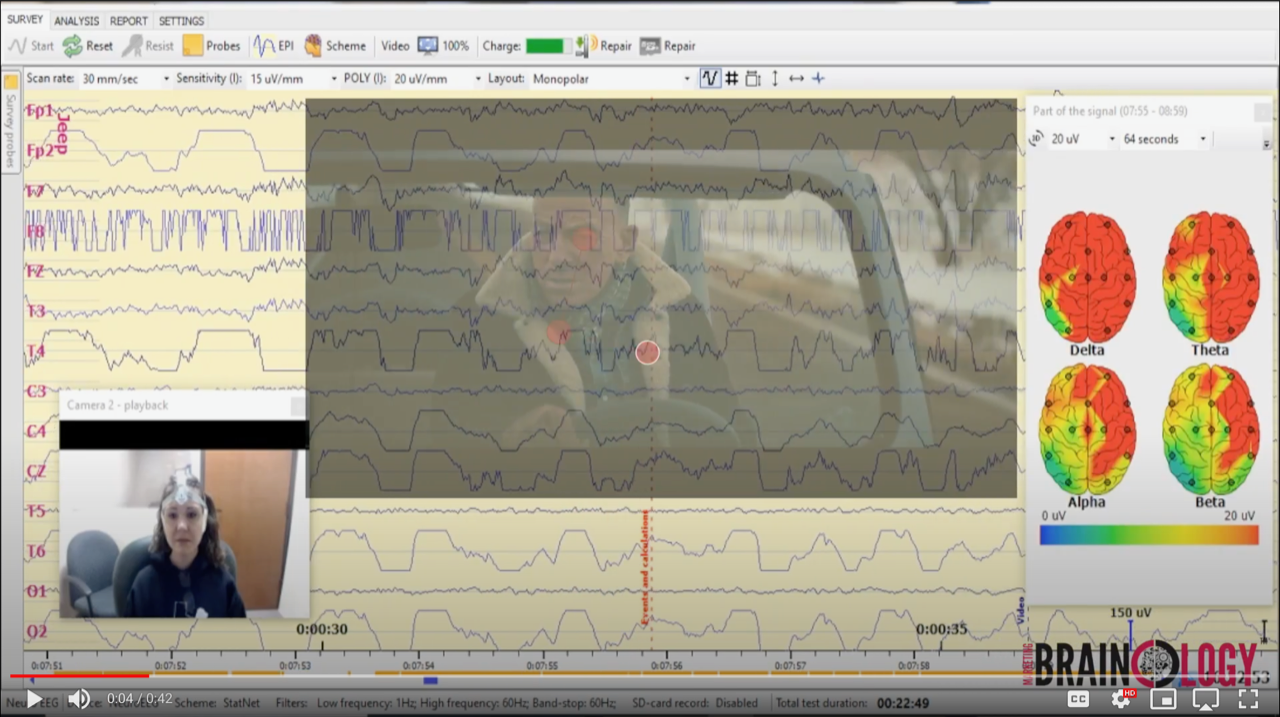

by Michelle Adams, PhD, President/Founder, Marketing Brainology, Plano, Texas, madams@marketingbrainology.com and Phoebe Springfield, Project Manager, Marketing Brainology, Plano, Texas
Have you ever been in a situation where you wonder whether someone is really telling you what they think and feel? As researchers, we generally rely on what people tell us regarding a topic. But often, what participants tell us does not include the deep-rooted emotions they’re experiencing. This can happen simply because they are not aware. Unfortunately, it leaves us with key elements we cannot “measure.” Yet, there are ways that we can capture and measure participants’ emotions that also enhance our understanding of their reactions to content.
What people are willing to say, what they think, and what they are actually willing to do are often quite different. For many, there are mental blocks that influence the opinions participants are willing—and able—to directly share with us. This mental block may be driven by a conscious decision. However, often, it is driven nonconsciously by previous experiences—System 1 level thinking, which is more emotional.
By understanding the art and science of human decision-making, neuroscience techniques can help brands, companies, and agencies create better emotional connections with consumers. We are not suggesting throwing out our previous research methods; instead, we can leverage additional tools.
What People Really Think, without Consciously Realizing It
Feelings and actions do not always align. People mask their true feelings for a variety of reasons, including:
- They are not aware of their true feelings.
- They don’t want others to know their feelings.
- They fear their views will be judged.
In today’s “cancel culture,” people have become more cautious of their views and have learned not to say anything publicly that might cause others to cancel or not support their views. The research setting is not immune to this trend; people can filter their true feelings or opinions in interviews, as well, for fear of being “canceled.”
Neuromarketing: A Three-Step Process
Using a three-step process, we can get more honest, accurate participant feedback. We leverage a combination of traditional and neuroscience tools, including sixteen-sensor electroencephalogram (EEG), eye-tracking, and in-depth interviews.

Step One includes connecting participants to their own sixteen-sensor EEG headset to monitor their brain activity. We measure their baseline brain activity prior to seeing content. This allows us to see how their brain reactions change as they see specific ads or other marketing content. These data allow us the ability to see which areas of the brain are activating while a respondent is viewing content. Participants’ brain reactions can vary greatly from one ad to the next.
We measure four brain waves: theta, delta, alpha, and beta waves. Each respondent’s brain will react differently based on the connection they have with the content and how well they like or dislike what they see. For example, if a young male loves Doritos, their brain is likely to react to a Doritos Super Bowl ad more than another ad. The best Super Bowl ads are able to activate the largest number of brains by being relatable across generations and demographic targets.
Step Two is to calibrate participants’ eyes for the Tobii eye-tracking portion. This allows us to accurately measure what participants specifically look at, whether that’s a commercial, packaging, website, or merchandising. Both the EEG and eye-tracking work in parallel to help us pinpoint precisely what someone is looking at while their brain is activated. We can calculate things such as their total eye fixation times and the time it takes to first see various parts of the content shown to them. In Super Bowl ads, brands want to ensure that their product is focused on at some point during the commercial. Often, this is not accomplished because there are too many other distractions in the ad. The eye-tracking data measures this with precision and answers the important question, “Was the product or brand logo seen?”
Step Three is to conduct an in-depth interview to get a better understanding of what participants truly think while viewing content. This provides greater depth of insights, especially where participants’ stated claims are not consistent with how participants’ brains react. Nonconscious reactions can be questioned, and additional insights revealed. We often see a brain activation when a memory is triggered. The linkage their brain makes to something shown to them isn’t always top-of-mind. Further probing helps us understand the rest of the story and allows us to question further. For example, we can ask about their previous history with a brand and what memory may have been triggered while watching an ad.
This three-step process delivers deeper insights to help agencies and brands test their products, ads, displays, and more before bringing them to market.
Super Bowl Commercials: A Case Study in Practical Application
Every year, our Super Bowl study measures an average of forty participants’ reactions to the commercials using our three-step process—leveraging EEG, eye-tracking, and in-depth interviews. These processes are done consecutively on the same day, to capture participants’ raw reactions to the ads, as these reactions have the potential to fade or be forgotten as time passes. Within the study, most major brands’ ads are tested, and we rank certain ads as top contenders based on all participants’ verbal and mental reactions. These ads are those with high brain activation and exclamations of love for the ads based on entertainment, moral, and relatable values. With an average cost of $5.6 million per 30-second ad (Gough, 2021, Statista), the stakes on getting viewers’ attention are high.
Brands are competing with viewers’ friends, family, food, and phones, in addition to the commercials played throughout the Super Bowl. Being remembered among all the Super Bowl ads is extremely challenging. Brands need to ensure that their message is reaching their target audience to get the necessary return on investment. The main goals of a successful Super Bowl ad are to be memorable and not create too much conflict; ultimately, they should help sell more of their product to their targeted consumers.

The Jeep ad was one of the most liked and disliked commercials within our Super Bowl study this year. The featured talent in the 2021 Jeep ad was Bruce Springsteen. Due to Springsteen’s previous political affiliations, some consumers were turned off by the ad. While not directly discussing their political beliefs with us, consumers told us they were unhappy with the connotation of the ad, and that Jeep should stick to selling cars. Seeing their EEG data in real-time allowed us to see their brain activation while watching this ad versus other Super Bowl ads they viewed. In particular, we saw higher alpha wave reactions among participants who either liked or disliked this ad. One respondent had a high 112uV alpha wave score and stated that they strongly disliked the ad.
On the other hand, some consumers liked the ad, feeling that Jeep’s message straddled the middle ground and was a good reminder to the country in these times of divided political allegiances. These consumers also scored high alpha waves, which is why the interview is so important in determining the positive or negative connotation of brain activity.
Some of the more reserved participants alluded to enjoying the ad or simply gracing it with little comment of like or dislike. Those with lower brain reactions were typically those who had little opinion on the matter and/or lost interest in the two-minute ad. These participants scored much lower alpha waves (closer to 25uV).
Because the Jeep ad elicited such an array of responses, we wonder whether their message will provide the return on investment they desire.
Among other tested ads, DoorDash and McDonald’s scored high with younger participants. Consumers in their twenties found these ads fun and relevant. One consumer scored a 183uV alpha score on the DoorDash ad, while averaging closer to a 12uV alpha wave score for most other ads.
The McDonald’s Super Bowl ad was able to activate the brains of some older participants as well, due to the music used in the ad. One respondent in his fifties scored an alpha score of 46uV, which was much higher than his alpha score on other ads. In his interview, he expressed a strong liking for the ad, especially the music used.
Testing Super Bowl ads annually has allowed us to build “The Principles of Effective Super Bowl Ads.” These principles are built on our three-step process to ensure we measure not only what participants say they like or dislike, but also, what their brains respond to.
With the stakes extremely high for Super Bowl ads, companies need to vet their ads, copy, and other marketing efforts before airing them. They need a data-driven approach to ensure their messages are delivered in the most effective way possible. This removes the guesswork.
Key Take-Aways
Participants are likely to filter what they say to us for one reason or another. Consciously or nonconsciously, an information gap needs to be filled. By combining EEG, eye-tracking, and in-depth interviews, we can change the way we view and understand people’s responses.
The use of EEG, along with traditional methods, gives us the opportunity to explore new depths of human understanding and connect with people in a way not previously possible. Adding these tools to your repertoire will help you take your research to new heights. In this age, it is crucial that messaging of any kind be tested before being rolled out to a target audience. Breaking through and reaching the minds of consumers amid all the other information coming at them is even more challenging today, so it becomes even more important to optimize our content to delight the brains and eyes of our most valuable consumers.
Four Brain Waves Explained
This is what each brain wave measures. We focus mostly on alpha and beta waves, as they provide data on the surface level and quick reactions that people have.

ALPHA:
- Motion, music, etc.
- Your brain picks up information from various sources
BETA:
- “Mirror Neurons”—experiencing something
- Active, busy, anxious thinking—concentration
- Becomes stronger when we execute movements
DELTA:
- Memory consolidation
- Acquired skills & learned information
THETA:
- These frequencies increase with difficulty of task
- Brain works harder—information is complex
- Navigation tasks—in real environments or virtual reality




